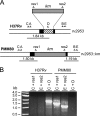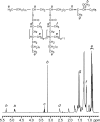Identification of the missing trans-acting enoyl reductase required for phthiocerol dimycocerosate and phenolglycolipid biosynthesis in Mycobacterium tuberculosis
- PMID: 17468241
- PMCID: PMC1913427
- DOI: 10.1128/JB.00169-07
Identification of the missing trans-acting enoyl reductase required for phthiocerol dimycocerosate and phenolglycolipid biosynthesis in Mycobacterium tuberculosis
Abstract
Phthiocerol dimycocerosates (DIM) and phenolglycolipids (PGL) are functionally important surface-exposed lipids of Mycobacterium tuberculosis. Their biosynthesis involves the products of several genes clustered in a 70-kb region of the M. tuberculosis chromosome. Among these products is PpsD, one of the modular type I polyketide synthases responsible for the synthesis of the lipid core common to DIM and PGL. Bioinformatic analyses have suggested that this protein lacks a functional enoyl reductase activity domain required for the synthesis of these lipids. We have identified a gene, Rv2953, that putatively encodes an enoyl reductase. Mutation in Rv2953 prevents conventional DIM formation and leads to the accumulation of a novel DIM-like product. This product is unsaturated between C-4 and C-5 of phthiocerol. Consistently, complementation of the mutant with a functional pks15/1 gene from Mycobacterium bovis BCG resulted in the accumulation of an unsaturated PGL-like substance. When an intact Rv2953 gene was reintroduced into the mutant strain, the phenotype reverted to the wild type. These findings indicate that Rv2953 encodes a trans-acting enoyl reductase that acts with PpsD in phthiocerol and phenolphthiocerol biosynthesis.
Figures





Similar articles
-
Delineation of the roles of FadD22, FadD26 and FadD29 in the biosynthesis of phthiocerol dimycocerosates and related compounds in Mycobacterium tuberculosis.FEBS J. 2010 Jun;277(12):2715-25. doi: 10.1111/j.1742-464X.2010.07688.x. FEBS J. 2010. PMID: 20553505
-
Molecular dissection of the biosynthetic relationship between phthiocerol and phthiodiolone dimycocerosates and their critical role in the virulence and permeability of Mycobacterium tuberculosis.FEBS J. 2007 Apr;274(8):1957-69. doi: 10.1111/j.1742-4658.2007.05740.x. Epub 2007 Mar 19. FEBS J. 2007. PMID: 17371506
-
Molecular dissection of the role of two methyltransferases in the biosynthesis of phenolglycolipids and phthiocerol dimycoserosate in the Mycobacterium tuberculosis complex.J Biol Chem. 2004 Oct 8;279(41):42584-92. doi: 10.1074/jbc.M406134200. Epub 2004 Aug 3. J Biol Chem. 2004. PMID: 15292265
-
Versatile polyketide enzymatic machinery for the biosynthesis of complex mycobacterial lipids.Nat Prod Rep. 2007 Apr;24(2):267-77. doi: 10.1039/b616817p. Epub 2007 Feb 28. Nat Prod Rep. 2007. PMID: 17389997 Review.
-
Long-chain multiple methyl-branched fatty acid-containing lipids of Mycobacterium tuberculosis: biosynthesis, transport, regulation and biological activities.Tuberculosis (Edinb). 2007 Mar;87(2):78-86. doi: 10.1016/j.tube.2006.05.003. Epub 2006 Oct 9. Tuberculosis (Edinb). 2007. PMID: 17030019 Review.
Cited by
-
Antibiotic Skeletal Diversification via Differential Enoylreductase Recruitment and Module Iteration in trans-Acyltransferase Polyketide Synthases.J Am Chem Soc. 2024 Mar 6;146(9):6114-6124. doi: 10.1021/jacs.3c13667. Epub 2024 Feb 23. J Am Chem Soc. 2024. PMID: 38389455 Free PMC article.
-
Building a better bacillus: the emergence of Mycobacterium tuberculosis.Front Microbiol. 2014 Apr 3;5:139. doi: 10.3389/fmicb.2014.00139. eCollection 2014. Front Microbiol. 2014. PMID: 24765091 Free PMC article. Review.
-
SBSPKS: structure based sequence analysis of polyketide synthases.Nucleic Acids Res. 2010 Jul;38(Web Server issue):W487-96. doi: 10.1093/nar/gkq340. Epub 2010 May 5. Nucleic Acids Res. 2010. PMID: 20444870 Free PMC article.
-
Comparative genomics of cell envelope components in mycobacteria.PLoS One. 2011 May 6;6(5):e19280. doi: 10.1371/journal.pone.0019280. PLoS One. 2011. PMID: 21573108 Free PMC article.
-
Carboxylation mechanism and stereochemistry of crotonyl-CoA carboxylase/reductase, a carboxylating enoyl-thioester reductase.Proc Natl Acad Sci U S A. 2009 Jun 2;106(22):8871-6. doi: 10.1073/pnas.0903939106. Epub 2009 May 20. Proc Natl Acad Sci U S A. 2009. PMID: 19458256 Free PMC article.
References
-
- Andi, B., P. F. Cook, and A. H. West. 2006. Crystal structure of the his-tagged saccharopine reductase from Saccharomyces cerevisiae at 1.7-Å resolution. Cell Biochem. Biophys. 46:17-26. - PubMed
-
- Azad, A. K., T. D. Sirakova, N. D. Fernandes, and P. E. Kolattukudy. 1997. Gene knockout reveals a novel gene cluster for the synthesis of a class of cell wall lipids unique to pathogenic mycobacteria. J. Biol. Chem. 272:16741-16745. - PubMed
-
- Belisle, J. T., and M. G. Sonnenberg. 1998. Isolation of genomic DNA from mycobacteria. Methods Mol. Biol. 101:31-44. - PubMed
-
- Camacho, L. R., P. Constant, C. Raynaud, M. A. Lanéelle, J. A. Triccas, B. Gicquel, M. Daffé, and C. Guilhot. 2001. Analysis of the phthiocerol dimycocerosate locus of Mycobacterium tuberculosis. Evidence that this lipid is involved in the cell wall permeability barrier. J. Biol. Chem. 276:19845-19854. - PubMed
-
- Cane, D. E., and C. T. Walsh. 1999. The parallel and convergent universes of polyketide synthases and nonribosomal peptide synthetases. Chem. Biol. 6:R319-R325. - PubMed
Publication types
MeSH terms
Substances
LinkOut - more resources
Full Text Sources
Molecular Biology Databases
Miscellaneous

